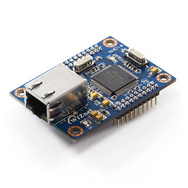For some reason or another, I got this silly idea of dropping a battery in a water saturated with salt :)
I thought, the salt will act as a conductor with resistance ~ 0 and Imagined all the sparking (really?! spark inside water! just imagine! :P)
I started with the Test Aperture :D
1- Resistance test leads

I cute two ~ 3 inch of steel wire and stripped out 5mm of insulation from both ends and soldered one end to binding post

which I fixed to a glass bottle's cover



And here I got some interesting results
the probes were about 7cm apart from each other (the bottle diameter is about 9cm)
resistance with tap water ~ 70K ohm
resistance with salt water ~ 14K ohm
what a finding!!!!!
This means with the battery inside the water, it won't effectively be a short-circuit, no sparking!!!!
it was kinda depressing, but I continued, I added temperature sensor (LM335) to MCU (ATmega168) to serial port on PC and then I logged the data
Once in water, I saw small bubbles forming on the negative pin and then going out, this continued and continued and continued without spark!!!, after sometime I got bored and stopped the data recording.
you can find the recorded raw data here : Temperature Readings
I graphed it on excel and I found this:

the x-axis numbers are just the index numbers, they dont mean anything, but it is actually for about 16 mins of continues data recording, I assume the ADC clock is maximum which is half the MCU clock which was 16MHz so the ADC is 8MHz
the y-axis is the decimal value of the ADC, so you can go:
V = 5*(y/1023)
V is the actual voltage read by the ADC
5 is the ADC reference voltage
y is the number from the file (the decimal value)
1023 is the ADC counts, for 10-bit ADC (2^10)
then to get the actual temperature, you use the formula from the data sheet of LM335 which is
V = 10mV / K
so
T (K) = V * 0.01
and you get the temperature in Kelvin, however, you might need to do initial calibration with a know temperature and then you subtract/add the calibration value to all other measured values.
Since I don't have this equipment, I used the raw decimal value to see the trend
here, I put the bottle outside and went to sleep, the next day:

what a mess!
of course, everything including the poor LM335 inside will all go to be disposed off the universe!
Shall I count it as a fail?!
why the resistance was large?!!
How can I decrease it?!!
I thought, the salt will act as a conductor with resistance ~ 0 and Imagined all the sparking (really?! spark inside water! just imagine! :P)
I started with the Test Aperture :D
1- Resistance test leads

I cute two ~ 3 inch of steel wire and stripped out 5mm of insulation from both ends and soldered one end to binding post

which I fixed to a glass bottle's cover



And here I got some interesting results
the probes were about 7cm apart from each other (the bottle diameter is about 9cm)
resistance with tap water ~ 70K ohm
resistance with salt water ~ 14K ohm
what a finding!!!!!
This means with the battery inside the water, it won't effectively be a short-circuit, no sparking!!!!
it was kinda depressing, but I continued, I added temperature sensor (LM335) to MCU (ATmega168) to serial port on PC and then I logged the data
Once in water, I saw small bubbles forming on the negative pin and then going out, this continued and continued and continued without spark!!!, after sometime I got bored and stopped the data recording.
you can find the recorded raw data here : Temperature Readings
I graphed it on excel and I found this:

the x-axis numbers are just the index numbers, they dont mean anything, but it is actually for about 16 mins of continues data recording, I assume the ADC clock is maximum which is half the MCU clock which was 16MHz so the ADC is 8MHz
the y-axis is the decimal value of the ADC, so you can go:
V = 5*(y/1023)
V is the actual voltage read by the ADC
5 is the ADC reference voltage
y is the number from the file (the decimal value)
1023 is the ADC counts, for 10-bit ADC (2^10)
then to get the actual temperature, you use the formula from the data sheet of LM335 which is
V = 10mV / K
so
T (K) = V * 0.01
and you get the temperature in Kelvin, however, you might need to do initial calibration with a know temperature and then you subtract/add the calibration value to all other measured values.
Since I don't have this equipment, I used the raw decimal value to see the trend
here, I put the bottle outside and went to sleep, the next day:

what a mess!
of course, everything including the poor LM335 inside will all go to be disposed off the universe!
Shall I count it as a fail?!
why the resistance was large?!!
How can I decrease it?!!






















































